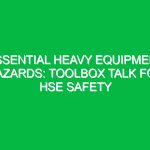Understanding Welding Hazards in the HSE Context
Welding is a vital process used across various industries, from construction to manufacturing. However, it comes with a range of inherent risks known as welding Hazards. These hazards pose significant threats to the health, safety, and Environment (HSE) of workers if not managed properly. Understanding these risks is not merely a matter of compliance; it is essential for promoting a culture of Safety and ensuring a secure workplace.
Welding hazards can lead to severe injuries, illnesses, and even fatalities. Therefore, comprehending these hazards is crucial for anyone involved in welding operations. In this article, we will explore the most significant welding hazards, their impacts on health and Safety, and effective strategies for mitigating these risks.
Types of Welding Hazards
The welding process presents a wide array of hazards. These can be categorized into physical, chemical, and ergonomic hazards.
Physical Hazards
Physical hazards are the most recognizable dangers in welding. They include:
- Fire and Explosions: The intense heat and sparks generated during welding can ignite flammable materials nearby. According to the National Fire Protection Association (NFPA), welding is one of the leading causes of industrial Fires.
- Electrical Shock: Welders often work with high-voltage equipment. If proper Safety Measures aren’t followed, they risk severe electrical shocks, which can lead to fatalities.
- Radiation Exposure: Welding produces harmful ultraviolet (UV) and infrared (IR) radiation. Prolonged exposure can cause skin Burns and eye damage, commonly known as “arc eye” or photokeratitis.
- Heat Stress: The heat generated during welding can lead to heat stress, especially in poorly ventilated areas. This can result in fatigue, dehydration, and heat-related illnesses.
Chemical Hazards
Welding operations also expose workers to various chemical hazards, including:
- Fumes and Gases: The welding process releases fumes that contain harmful metals such as manganese, lead, and cadmium. Inhalation can lead to respiratory issues and long-term health problems.
- Flammable Materials: Many welding processes involve the use of gases such as acetylene and oxygen, which are highly flammable. Improper handling can result in explosions.
Ergonomic Hazards
Welders often work in awkward positions for extended periods, leading to ergonomic hazards. These include:
- Musculoskeletal Disorders (MSDs): Repetitive motions and poor posture can lead to chronic pain and conditions such as carpal tunnel syndrome.
- Fatigue: Long hours of welding without proper breaks can lead to mental and physical fatigue, increasing the risk of accidents.
Best Practices for Managing Welding Hazards
Effective management of welding hazards requires a combination of Training, personal protective equipment (PPE), and adherence to safety protocols. Here are some Best Practices:
1. Comprehensive Training
Training is critical for all workers involved in welding. It should cover the following:
- Identification of welding hazards
- Proper use of equipment and PPE
- Emergency response Procedures
Regular refresher courses ensure that workers remain aware of the latest safety practices and technologies.
2. Personal Protective Equipment (PPE)
PPE is essential for protecting welders from various hazards. Necessary items include:
- Welding Helmets: These protect against UV and IR radiation and shield the face from sparks and heat.
- Respirators: Respiratory protection is vital in environments where fumes and gases are present.
- Gloves and Protective Clothing: Flame-resistant gloves and clothing protect against burns and cuts.
3. Proper Ventilation
Adequate ventilation is crucial in minimizing the risks associated with chemical exposures. Employers should ensure that welding areas are well-ventilated or use local exhaust systems to capture harmful fumes at the source.
4. Regular Maintenance and Inspections
Regular maintenance of welding equipment can prevent Electrical Hazards and reduce the risk of fires. Employers should conduct routine inspections to ensure that equipment is functioning correctly and that safety features are in place.
Real-Life Examples of Welding Hazards
Understanding how welding hazards manifest in real life can provide valuable insights into their impacts. For instance, a case documented by the Occupational Safety and Health Administration (OSHA) highlighted an incident where a welder suffered severe burns due to inadequate fire protection measures. The welder was working in proximity to flammable materials, and a spark ignited a fire, leading to serious injuries. This case underscores the necessity of following safety protocols rigorously.
Another example involves respiratory issues stemming from prolonged exposure to welding fumes. A study published in the American Journal of Industrial Medicine revealed that welders who did not use proper respiratory protection reported higher rates of chronic respiratory conditions compared to their counterparts who adhered to Safety Guidelines. This illustrates the critical nature of using appropriate PPE and maintaining a safe working environment.
Regulations and Standards Governing Welding Hazards
Several Regulations and standards govern safety practices in welding, which are crucial for minimizing hazards. Key regulations include:
- Occupational Safety and Health Administration (osha): OSHA provides guidelines for the safe Operation of welding equipment and the necessary protective measures.
- American National Standards Institute (ANSI): ANSI standards outline the requirements for PPE used in welding to ensure adequate protection for workers.
- National Fire Protection Association (NFPA): NFPA standards address fire safety in welding operations, providing guidelines for Fire Prevention and emergency response.
Compliance with these regulations not only protects workers but also helps organizations avoid legal liabilities and financial penalties.
Conclusion: The Importance of Addressing Welding Hazards
In conclusion, welding hazards present significant risks that can lead to serious health and safety issues if not adequately addressed. Understanding the types of welding hazards—physical, chemical, and ergonomic—is vital for anyone involved in welding operations. By adopting Best Practices such as comprehensive training, the use of PPE, proper ventilation, and regular maintenance, organizations can significantly mitigate these risks.
Moreover, compliance with regulatory standards is essential for creating a safe working environment. The primary goal should always be to protect workers while promoting efficiency and productivity. As the industry evolves, so too must our approaches to safety. By remaining vigilant and proactive, we can unlock safety and ensure a secure workplace for all involved in the welding profession.


